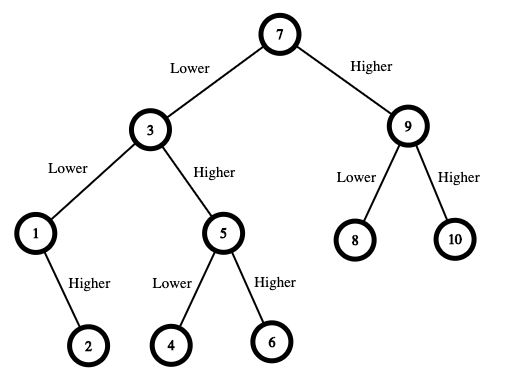We are playing the Guessing Game. The game will work as follows:
- I pick a number between
1andn. - You guess a number.
- If you guess the right number, you win the game.
- If you guess the wrong number, then I will tell you whether the number I picked is higher or lower, and you will continue guessing.
- Every time you guess a wrong number
x, you will payxdollars. If you run out of money, you lose the game.
Given a particular n, return the minimum amount of money you need to guarantee a win regardless of what number I pick.
Example 1:
Input: n = 10 Output: 16 Explanation: The winning strategy is as follows: - The range is [1,10]. Guess 7. - If this is my number, your total is 0. Otherwise, you pay 7. - If my number is higher, the range is [8,10]. Guess 9. - If this is my number, your total is 7. Otherwise, you pay 9. - If my number is higher, it must be 10. Guess 10. Your total is 7 + 9 = 16. - If my number is lower, it must be 8. Guess 8. Your total is 7 + 9 = 16. - If my number is lower, the range is [1,6]. Guess 3. - If this is my number, your total is 7. Otherwise, you pay 3. - If my number is higher, the range is [4,6]. Guess 5. - If this is my number, your total is 7 + 3 = 10. Otherwise, you pay 5. - If my number is higher, it must be 6. Guess 6. Your total is 7 + 3 + 5 = 15. - If my number is lower, it must be 4. Guess 4. Your total is 7 + 3 + 5 = 15. - If my number is lower, the range is [1,2]. Guess 1. - If this is my number, your total is 7 + 3 = 10. Otherwise, you pay 1. - If my number is higher, it must be 2. Guess 2. Your total is 7 + 3 + 1 = 11. The worst case in all these scenarios is that you pay 16. Hence, you only need 16 to guarantee a win.
Example 2:
Input: n = 1 Output: 0 Explanation: There is only one possible number, so you can guess 1 and not have to pay anything.
Example 3:
Input: n = 2 Output: 1 Explanation: There are two possible numbers, 1 and 2. - Guess 1. - If this is my number, your total is 0. Otherwise, you pay 1. - If my number is higher, it must be 2. Guess 2. Your total is 1. The worst case is that you pay 1.
Constraints:
1 <= n <= 200
class Solution:
def getMoneyAmount(self, n: int) -> int:
dp = [[0] * (n + 10) for _ in range(n + 10)]
for l in range(2, n + 1):
for i in range(1, n - l + 2):
j = i + l - 1
dp[i][j] = inf
for k in range(i, j + 1):
t = max(dp[i][k - 1], dp[k + 1][j]) + k
dp[i][j] = min(dp[i][j], t)
return dp[1][n]class Solution {
public int getMoneyAmount(int n) {
int[][] dp = new int[n + 10][n + 10];
for (int l = 2; l <= n; ++l) {
for (int i = 1; i + l - 1 <= n; ++i) {
int j = i + l - 1;
dp[i][j] = Integer.MAX_VALUE;
for (int k = i; k <= j; ++k) {
int t = Math.max(dp[i][k - 1], dp[k + 1][j]) + k;
dp[i][j] = Math.min(dp[i][j], t);
}
}
}
return dp[1][n];
}
}class Solution {
public:
int getMoneyAmount(int n) {
vector<vector<int>> dp(n + 10, vector<int>(n + 10));
for (int l = 2; l <= n; ++l) {
for (int i = 1; i + l - 1 <= n; ++i) {
int j = i + l - 1;
dp[i][j] = INT_MAX;
for (int k = i; k <= j; ++k) {
int t = max(dp[i][k - 1], dp[k + 1][j]) + k;
dp[i][j] = min(dp[i][j], t);
}
}
}
return dp[1][n];
}
};func getMoneyAmount(n int) int {
dp := make([][]int, n+10)
for i := 0; i < len(dp); i++ {
dp[i] = make([]int, n+10)
}
for l := 2; l <= n; l++ {
for i := 1; i+l-1 <= n; i++ {
j := i + l - 1
dp[i][j] = math.MaxInt32
for k := i; k <= j; k++ {
t := max(dp[i][k-1], dp[k+1][j]) + k
dp[i][j] = min(dp[i][j], t)
}
}
}
return dp[1][n]
}
func max(a, b int) int {
if a > b {
return a
}
return b
}
func min(a, b int) int {
if a < b {
return a
}
return b
}
